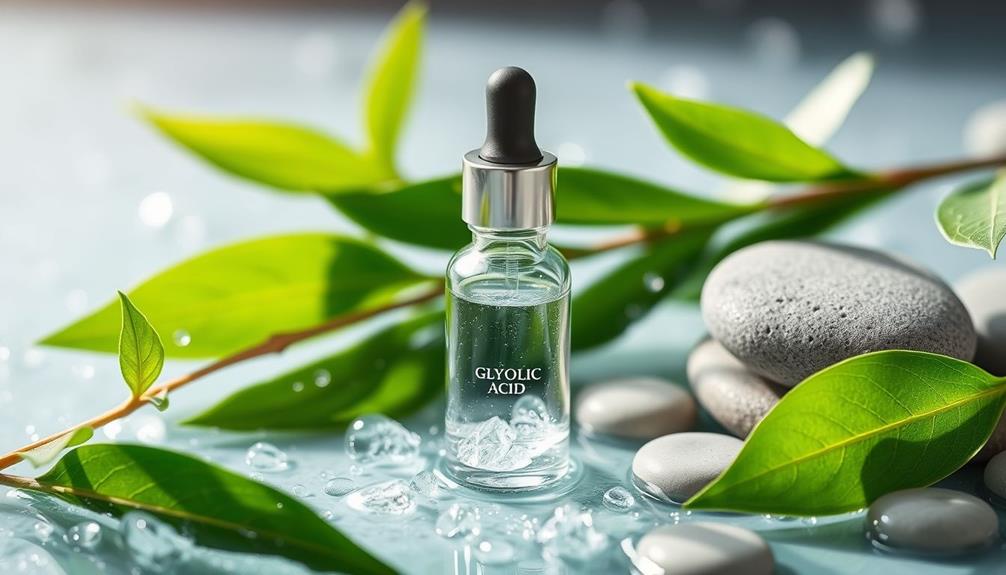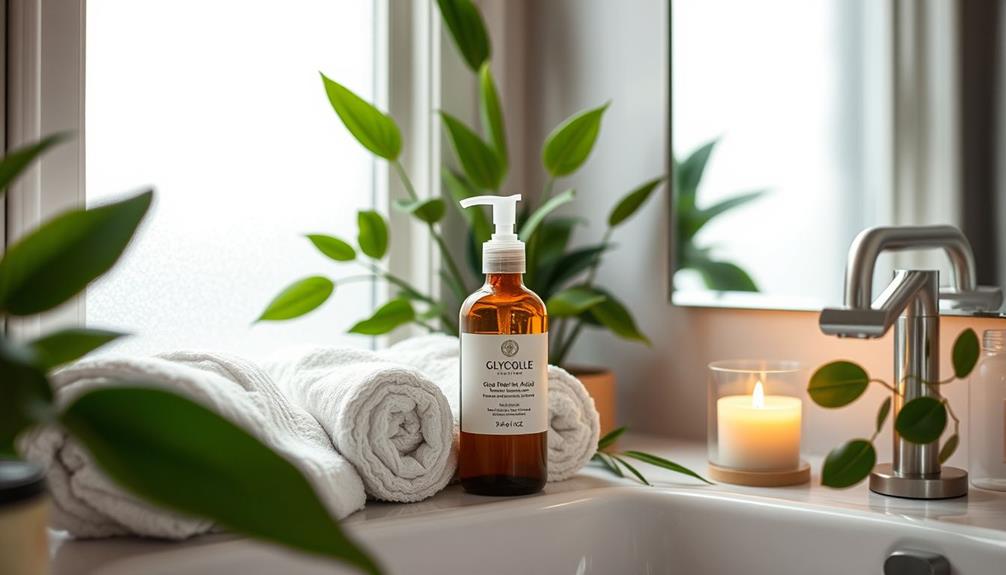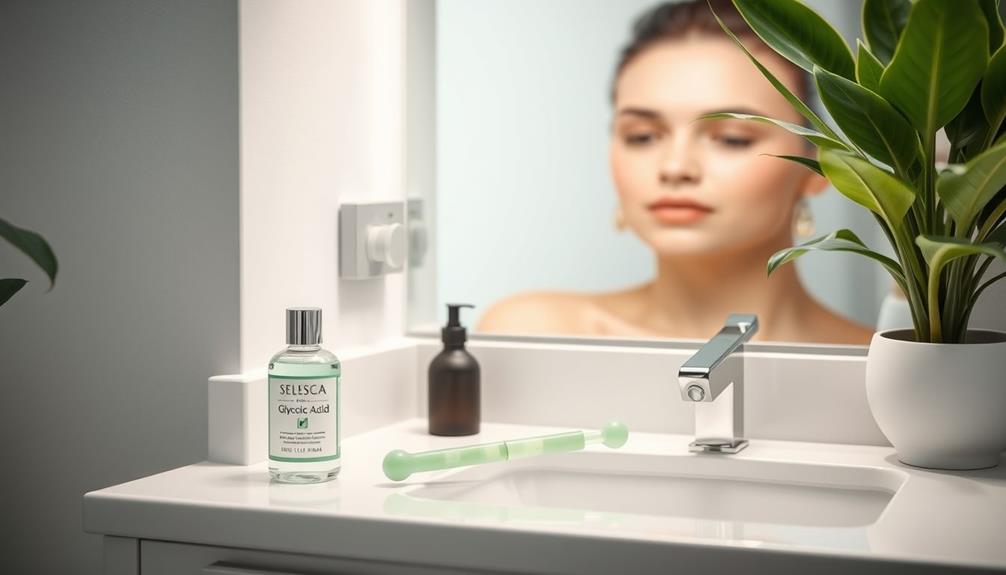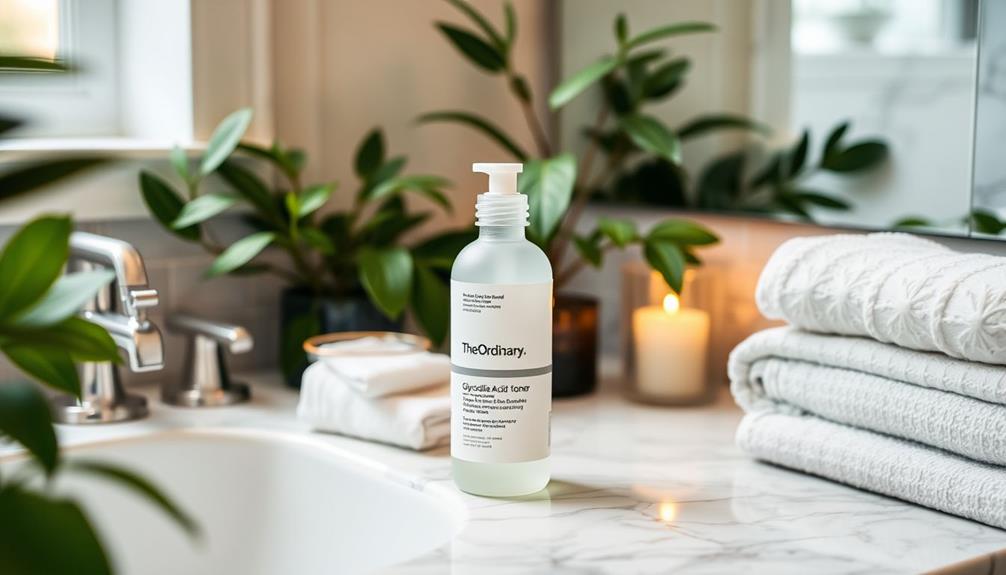Glycolic acid is the ultimate ingredient for achieving healthy skin. It effectively removes dead skin cells, resulting in a smoother and more radiant complexion. Thanks to its small molecular size, it can deeply penetrate the skin, enhancing cell turnover and hydration. By boosting collagen production, it enhances skin elasticity and reduces fine lines and signs of aging. Additionally, it is effective in treating acne by unclogging pores. It is important to consider your skin type and start with lower concentrations to prevent irritation. There are countless possibilities when combining glycolic acid with other ingredients for optimal results.
Key Takeaways
- Glycolic acid, derived from sugarcane, effectively exfoliates skin and promotes cell turnover for a smoother complexion.
- It enhances hydration, boosts collagen production, and improves skin elasticity, making it essential for anti-aging skincare.
- Regular use can reduce acne, diminish fine lines, and repair sun damage while promoting an even skin tone.
- Combining glycolic acid with azelaic acid or hyaluronic acid enhances its effectiveness and addresses various skin concerns.
Overview of Glycolic Acid

Glycolic acid, a naturally occurring alpha hydroxy acid from sugarcane, is renowned for its powerful exfoliation and skin renewal abilities.
As you incorporate glycolic acid into your skincare routine, you'll notice its small molecular size allows it to penetrate deeply into the skin. This deep penetration enables effective exfoliation, helping to dissolve dead skin cells and oils, which results in a smoother, more radiant complexion.
Additionally, products that utilize skincare patches can enhance the effects of glycolic acid by delivering concentrated ingredients directly to the skin.
Not only does glycolic acid promote cell turnover, but it also enhances hydration. Acting as a humectant, it attracts moisture to your skin, keeping it plump and hydrated. This dual action of exfoliation and hydration is essential for achieving healthy skin.
Additionally, regular use of glycolic acid can boost collagen production, improving your skin's elasticity and structure.
This means not only will your skin feel softer and look brighter, but it will also become more resilient over time.
Whether you're addressing acne or the visible signs of aging, glycolic acid is a versatile ingredient that can help you achieve your skincare goals while promoting a youthful appearance.
Benefits for Skin Health

Incorporating glycolic acid into your routine offers numerous benefits for skin health, making it a standout choice for achieving a vibrant and youthful complexion.
This powerful alpha hydroxy acid effectively exfoliates your skin by dissolving dead skin cells, leading to a smoother and more radiant appearance. Because of its small molecular size, glycolic acid penetrates deeply into the epidermis, promoting collagen production and enhancing skin elasticity. This results in a firmer look, helping to combat fine lines and wrinkles.
Additionally, incorporating essential oils into your skincare routine can complement glycolic acid by providing soothing and nourishing properties.
Regular use of glycolic acid can appreciably diminish the signs of aging, making it a must-have in your anti-aging skincare arsenal. Additionally, it's beneficial for treating acne, as it unclogs pores and reduces the formation of comedones, contributing to clearer skin over time.
Glycolic acid also aids in repairing sun damage, addressing hyperpigmentation, and promoting an even skin tone. By incorporating this ingredient into your skincare routine, you'll not only enhance your overall skin health but also enjoy a brighter, more youthful complexion that radiates confidence.
Effective Combinations
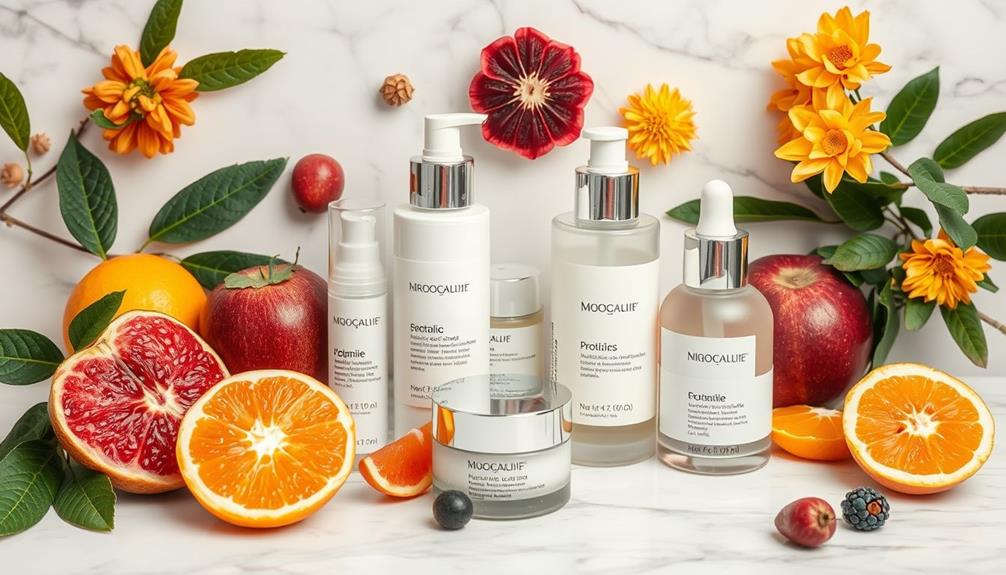
Effective combinations of glycolic acid with other skincare ingredients can greatly enhance your results, targeting specific concerns like blemishes and uneven skin tone.
For instance, pairing glycolic acid with azelaic acid effectively improves absorption and addresses uneven texture. If you're dealing with acne or brown acne scars, consider alternating glycolic acid with retinol. This duo works wonders, but be mindful to use them on different nights to minimize skin dryness.
Additionally, incorporating essential oils for skin health can complement your routine; oils like tea tree have antimicrobial properties that may further support your skin's clarity and balance essential oils for skin health.
When layering glycolic acid with other actives, caution is essential. Mixing it with salicylic acid can lead to increased dryness and irritation, so it's best to avoid that combination.
Additionally, steer clear of layering niacinamide with glycolic acid; their differing pH levels can hinder glycolic's effectiveness.
If you have sensitive skin types, alternating glycolic acid with retinol can optimize results while reducing irritation risk.
By understanding these effective combinations, you can tailor your skincare routine to address specific concerns, ensuring your skin stays healthy and radiant.
Always listen to your skin's needs and adjust your regimen accordingly for the best outcomes.
Risks and Precautions

Using glycolic acid can enhance your skincare routine, but it's vital to be aware of potential risks and precautions to protect your skin's health.
This active ingredient can increase skin sensitivity, particularly to UV rays, making daily sunscreen use fundamental. It's also important to take into account the impact of combining glycolic acid with other active ingredients, as this can amplify skin irritation potential risks of combining ingredients.
If you're thinking about adding glycolic acid to your regimen, keep these points in mind:
- Common side effects: Redness, itching, swelling, and burning sensations can occur, especially if you have sensitive skin.
- Skin irritation: Overusing glycolic acid or using high concentrations can worsen existing skin conditions, so apply it with caution.
- Hyperpigmentation risk: Irritation from glycolic acid can lead to hyperpigmentation, particularly in individuals with darker skin tones.
Research and Evidence

Research consistently shows glycolic acid's remarkable ability to promote skin cell renewal and enhance overall skin texture, making it a popular choice for treating various conditions.
Studies have demonstrated its effectiveness in acne treatment, particularly when combined with other ingredients like azelaic acid. This combination enhances absorption and boosts overall efficacy, making it a go-to for those struggling with breakouts. Additionally, understanding the emotional impact of skin conditions can aid in fostering resilience and patience, much like the supporting elderly mothers with BPD approach that emphasizes empathy and stability.
Furthermore, research indicates that glycolic acid aids in reducing acne scars, showcasing its role in skin regeneration and healing. Its anti-aging properties are well-documented, as ongoing studies emphasize the compound's ability to improve skin hydration when paired with hyaluronic acid.
Additionally, glycolic acid has proven beneficial in treating hyperpigmentation issues, such as melasma, with clinical trials illustrating significant improvements through glycolic acid peels.
The Journal of Cosmetic Dermatology published findings that support these claims, highlighting glycolic acid's effectiveness in pigmentation treatments.
As research continues, the dermatological community is increasingly validating glycolic acid's multifaceted benefits, establishing it as an essential ingredient for achieving healthy, radiant skin.
Diagnostic Considerations
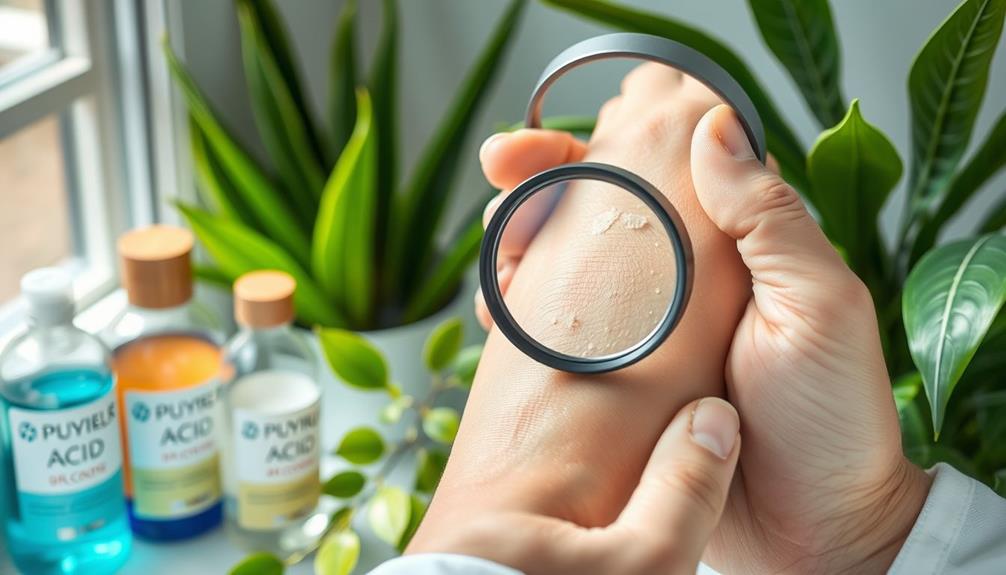
When using glycolic acid, evaluating your skin type is essential for effective treatment.
Additionally, understanding your personal health factors, similar to the importance of discussing personal risk factors in mammography effectiveness, can help customize your skincare routine.
You'll also want to assess your sensitivity to ingredients and monitor any reactions to guarantee safety and optimize results.
Keeping track of how your skin responds will help you adjust your routine for the best outcomes.
Skin Type Assessment
Identifying your skin type—whether oily, dry, combination, or sensitive—is fundamental for choosing the right glycolic acid concentration and formulation. This skin type assessment helps you avoid irritation and guarantees that your glycolic acid treatment is effective in treating signs of skin aging.
Consider these key points as you evaluate your skin:
- Oily Skin: You might need a higher concentration to combat excess oil.
- Dry Skin: A gentler formulation can help avoid further dryness.
- Combination Skin: Adjust your routine to cater to different areas of your face.
Regular skin sensitivity assessments and professional consultations can provide insights into your specific needs, helping you tailor your skincare routine effectively.
It's critical to monitor how your skin responds to glycolic acid products and adjust usage based on your skin's tolerance. By understanding your unique skin type and environment, you can maximize the benefits of glycolic acid, guaranteeing a safe and healthy skincare experience.
Ingredient Sensitivity Evaluation
How sensitive your skin is to glycolic acid can greatly influence your skincare routine and its effectiveness. Conducting an ingredient sensitivity evaluation is essential before introducing glycolic acid into your regimen. Understanding your individual skin type helps identify specific skin conditions and sensitivities, ensuring you avoid adverse reactions.
As you start using glycolic acid, it's important to monitor skin reactions closely. Some individuals may experience redness, irritation, or dryness, indicating that adjustments are needed. Tailoring the concentration and frequency of glycolic acid use based on your sensitivity can prevent over-exfoliation, which can damage skin health rather than enhance it.
Regular skin assessments play a significant role in optimizing the effectiveness of glycolic acid products. These evaluations allow you to fine-tune your skincare routine, including adjusting combinations with other active ingredients.
Being proactive about ingredient sensitivity will help you achieve the best results while promoting a healthy complexion. Remember, a personalized approach is key to maximizing the benefits of glycolic acid while minimizing potential drawbacks.
Reaction Monitoring Techniques
Monitoring your skin's reaction to glycolic acid is essential for adjusting your routine and ensuring ideal results. By paying attention to how your skin responds, you can effectively manage hydration levels and minimize irritation.
Here are some key techniques to help you with monitoring:
- Start Slow: Introduce glycolic acid products gradually, beginning with lower concentrations to see how your skin reacts.
- Perform Patch Tests: Always test a small area of skin before full application to gauge tolerance and avoid adverse reactions.
- Keep a Skincare Journal: Document changes in your skin condition, helping you understand how glycolic acid affects your unique skin type over time.
Recommendations for Use

When you start using glycolic acid, choose products with a low concentration of around 5% to keep irritation at bay.
It's best to apply it in the evening, so you can minimize sun sensitivity.
Remember to introduce one product at a time and keep an eye on how your skin reacts.
Start With Low Concentrations
To minimize irritation and help your skin adjust, start with glycolic acid products at a low concentration of around 5%. This allows your skin to acclimate while reaping the benefits of healthier skin.
It's crucial to choose formulations with a pH around 4, as this matches your skin's natural balance, improving effectiveness without overwhelming it.
Here are a few tips to keep in mind:
- Gradually introduce the product: Use glycolic acid once or twice a week initially.
- Monitor your skin's response: Pay attention to how your skin reacts before increasing the frequency.
- Opt for leave-on products: Serums or toners are preferable, as they provide prolonged contact with your skin.
Apply at Night
Applying glycolic acid at night helps protect your skin from sun sensitivity and potential UV damage. Since glycolic acid can increase your skin's vulnerability to sunlight, it's crucial to incorporate it into your nighttime skincare routine.
Start with a low concentration, around 5%, to let your skin acclimate. Initially, apply it once or twice a week, and then you can gradually increase frequency as your skin adjusts.
For the best results, choose leave-on treatments like serums or creams, as they provide enhanced efficacy compared to wash-off products like cleansers. This way, you guarantee that glycolic acid penetrates deeply and works effectively overnight.
Monitor Skin Reactions
It's vital to monitor your skin reactions closely when you start using glycolic acid to guarantee a safe and effective experience. As you incorporate this powerful ingredient into your skincare routine, pay attention to any signs of irritation or skin sensitivity.
Here are some recommendations to help you stay on track:
- Start with a low concentration (about 5%) and gradually increase as your skin builds tolerance.
- Keep an eye out for adverse reactions like redness, itching, or swelling, and adjust usage frequency or concentration accordingly.
- Use glycolic acid products primarily at night to minimize the risk of sun sensitivity.
If you experience persistent irritation or have specific skin conditions, don't hesitate to consult with a dermatologist. They can provide tailored advice to help you achieve healthy skin without compromising your comfort.
Frequently Asked Questions
What Does Glycolic Acid Do for Your Skin?
Glycolic acid exfoliates your skin, unclogs pores, and boosts cell turnover. It hydrates by attracting moisture, reduces fine lines, and helps even out skin tone, giving you a smoother, more radiant complexion over time.
Is It Good to Use Glycolic Acid Everyday?
Is daily use of glycolic acid a good idea? It can be beneficial, but starting slow is key. You should monitor your skin's reaction and alternate with other treatments to avoid irritation and sensitivity.
What Not to Pair With Glycolic Acid?
When using glycolic acid, avoid pairing it with salicylic acid, lactic acid, niacinamide, retinol, or vitamin C. These combinations can irritate your skin, reduce effectiveness, and compromise your skin barrier. Always prioritize your skin's health.
What Food Has the Most Glycolic Acid?
You might think pizza is the secret to glowing skin, but it's actually sugarcane that boasts the highest glycolic acid concentration. Fruits like pineapple and apples come next, giving your skin a delicious boost!
Conclusion
Incorporating glycolic acid into your skincare routine can be like adding a secret weapon to your beauty arsenal.
With its powerful exfoliating properties and skin-renewing benefits, it helps you achieve that radiant glow you've been longing for.
Just remember to start slowly and pay attention to your skin's needs.
By doing so, you'll access the full potential of this essential ingredient and enjoy healthier, more vibrant skin in no time.
Embrace the transformation!

